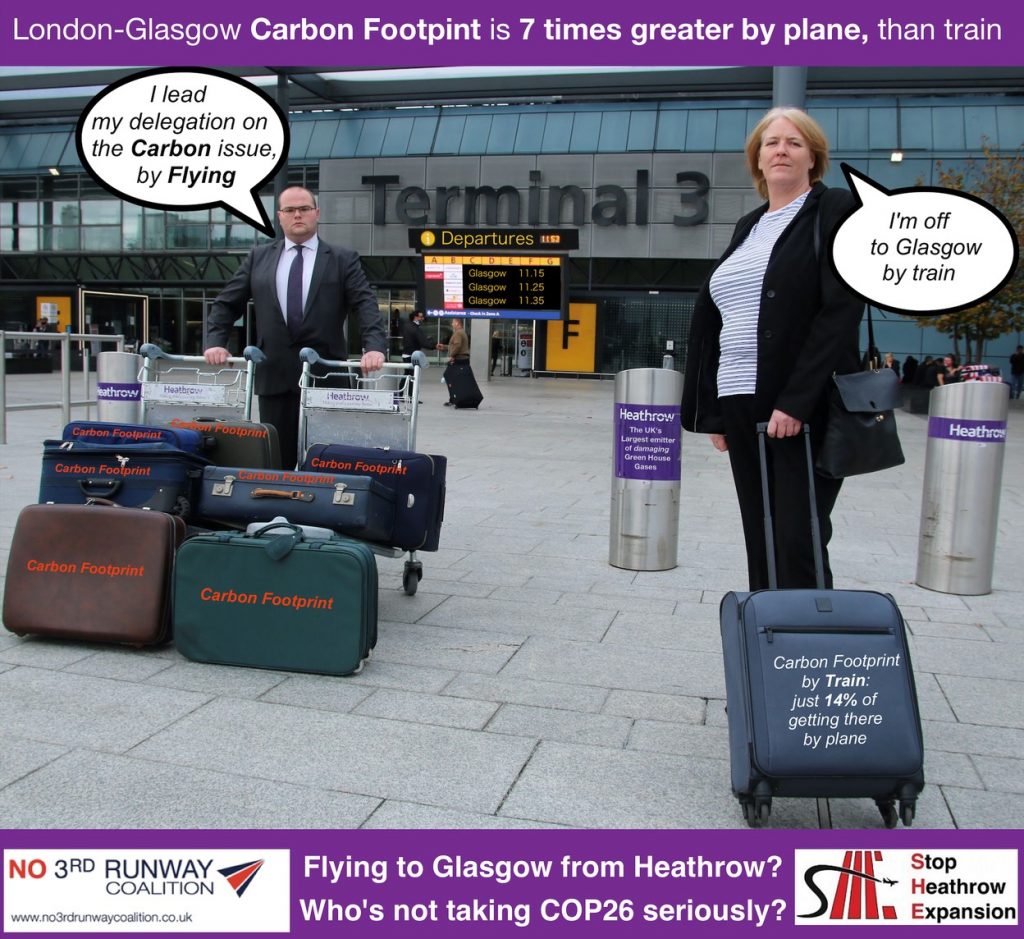
With its modest achievements, the UN Climate Change Conference (October 31-November 12, 2021)—popularly known as COP26—was a disappointment to say the least. Among the many areas in which the gathering fell short was aviation.
According to one aviation sector publication, “COP26 ends with a broad agreement across the industry that they will target net zero by 2050, in line with the Paris Agreement.” Key to this agreement was what took place a few weeks before COP26 when, at the annual meeting of the International Air Transport Association (IATA), nearly 300 of the world’s biggest airlines endorsed a net-zero resolution.
Willie Walsh, the IATA director general, insists that the commitment is “a big deal.” But what it means in practice is an open question at best. Most likely, it means little–at least for the foreseeable future.
As climate scientist Kevin Anderson asserted in an interview during COP26, “Everyone is now using this expression ‘net zero.’ You can be a net zero oil company. You can be net zero Saudi Arabia or Qatar or Norway or the U.K. or the U.S. Everyone can become net zero, every county, every company. It’s vacuous. It’s completely meaningless. When you unpick what’s behind net zero, I mean, all it is, I often say, is it’s Latin for kicking the can down the road. It’s passing the burden on to the next generation.”
“[Net zero is] Latin for kicking the can down the road. It’s passing the burden on to the next generation.” –Kevin Anderson
Indeed, that same aviation industry publication admits in relation to the net zero target, “how aviation will get there remains less clear.” It seems to assume “new technologies will plug the gap and in the shorter-term there is huge reliance on Sustainable Aviation Fuels (SAF), although scaling these up to the level required will be challenging.”
(That “scaling up will be challenging” has not prevented airlines from continuing to greenwash their activities and plans for expansion. United Airlines, for example, announced in June that it would spend $3 billion on supersonic jets—which use 5-7 times as much fuel as conventional aircraft. Not to worry, says United: the supersonic jets will be designed to run on 100% sustainable aviation fuels—produced from recycled cooking oil, agricultural waste, and other materials—making the flights “net zero.” Cait Hewitt, policy director of the London-based Aviation Environment Federation, calls plans to put these fuels into supersonic jets “an insane use of scarce resources.”)
A small way COP26 could have displayed a strong commitment to dealing with aviation-related emissions was by limiting air travel to and from the gathering. Instead, as noted by many media outlets, the conference involved an inordinate amount of flying—a lot of it by private jet.
According to one report, more than 400 private jets carried world leaders and business executives to the Glasgow gathering—this as the World Meteorological Association announced that the annual rate of sea level rise had doubled since the 1990s. U.S. President Joe Biden and his entourage, for example, arrived in four planes; those alone generated an estimated 980 tons of C02 emissions.
Other jet-setting VIPs arriving by private jet included Microsoft multibillionaire Bill Gates and Jeff Bezos, head of Amazon, which pledges to reach “net-zero carbon” by 2040. UK Prime Minister Boris Johnson flew back and forth from London, and Prince Charles flew in from Rome—after ensuring that his plane was using “sustainable aviation fuel.”
There are many reasons to protest such profligate consumption, one being that it enshrines double standards, while undercutting the perception that rapid and far-reaching decarbonization is needed. As the UK Labor Party’s Net Zero spokeswoman Monica Lennon asserted, “Flying by private jet while claiming to care passionately about tackling the climate emergency really is rank climate hypocrisy. It goes against what all of these national leaders tell people they should be doing – they should be leading by example.”
“Flying by private jet while claiming to care passionately about tackling the climate emergency really is rank climate hypocrisy. It goes against what all of these national leaders tell people they should be doing – they should be leading by example.” — Monica Lennon, UK Labor Party’s Net Zero spokeswoman
Another one is human life itself. It is conservatively estimated that private jet travel to and from COP26 resulted in 13,000 metric tons of emissions (to say nothing of the emissions associated with the thousands who arrived by commercial aircraft). According to a recent study published in Nature Communications, every 4,434 tons of emitted CO2 leads to one premature death due to rising temperatures. By this measure, private jet travel to and from COP26 translates into about three excess fatalities.
What is to be done about this? Environmental writer Dharna Noor suggests a global ban on private jets or, at the very least, a 100% tax on private jets and travel to help fund the Green Climate Fund.
More broadly, what is needed is a rethinking of the very organization of international climate meetings. If academics are increasingly adapting how they meet and collaborate, should we not demand the same of national and international leaders? Why not make the meetings virtual—which would have the added advantage of allowing a lot more to attend? The notion that face-to-face contact is needed for the hard conversations that such conferences involve is belied by their impoverished results.
What really explains these fossil-fuel-dependent events is force of habit—and an effective refusal of the rich and powerful to challenge their wasteful ways.
This is also a problem of infrastructure as the very presence of airports and their continued growth allows for ever more business as usual. And the ways in which some of them are run promotes obscene waste. Here’s an example: according to recent reports, there is a strong possibility that Lufthansa will have to fly 18,000 empty planes to maintain take-off and landing slots at airports in Europe.
The centrality of infrastructure is a key reason why anti-airport fights are so important—and why they are growing in number. As Eraldo Souza dos Santos notes in The Washington Post, “Over the past couple of decades, there’s been a worldwide increase in local anti-airport movements, motivated both by global climate concerns and by local worries about issues such as water pollution and displacing poor or minority communities.” He observes that a combination of global concerns—e.g., climate breakdown—and local ones (land rights, biodiversity, air and noise pollution, for example) typically motivate these movements. “This combination of local concerns with global focus may help explain why these protest movements endure,” he writes.
Anti-airport movements also have a considerable history, one that goes back to at least the mid-1960s, to draw upon, dos Santos points out in a different article. In addition, these movements now take place across the global: “From Peru and Uganda to the United States and India, disparate groups of citizens have organized against the environmental and local impacts of airport land development., For dos Santos, another expression is the organization Stay Grounded, an international network of 170 activist organizations around the world. Like Global Anti-Aerotropolis Movement, Stay Grounded seeks to build links between local campaigns and organizations.

New resources
Speaking of Stay Grounded, the group (along with the Green European Foundation) has just released a new report, “A Guide to Engaging Aviation Workers and Trade Unions.” As “climate campaigners are coalescing around an agenda of no expansion of airports and the need for a long-term reduction of aviation,” Stay Grounded insists that it is imperative that the perspective of workers be taken into consideration. The guide recommends five steps: 1) understand unions and workers by building relations of trust; 2) lead on jobs by prioritizing alternative, quality employment for workers displaced by anti-airport efforts; 3) focus on future threats by emphasizing how the climate and broad ecological crisis threatens workers, making the need for a rapid, just transition imperative; 4) support the demands of workers and trade unions in abroad sense; and 5) avoid generalizations by being sensitive to the specific circumstances of the workers and contexts that you are engaging.
Have you ever wondered about the size of your local airport’s carbon footprint? The International Council on Clean Transportation (headquartered in Washington, D.C.), ODI (London), and Transport and Environment (Brussels) have produced an online tool that measures the C02 emissions generated by departing aircraft from airports around the world. Airport Tracker “contains information for the 1,300 largest global airports, covering 99% of global airline passenger traffic.” (It does not cover emissions for cargo-related aviation.) Via the Tracker, one learns, for example, that flights departing from LAX (Los Angeles International Airport) emitted 15.3 million tons of CO2. This amount is equivalent to all of that emitted by Slovenia (a country of 2.1 million people) and more than that by Tanzania (with a population of 61.5 million) in 2019.
To see Part 2 of the “Dec. 2021/Jan. 2022 Update,” go here.


